An Exclusive Interview With
SAMUEL CORUM
By José Jeuland
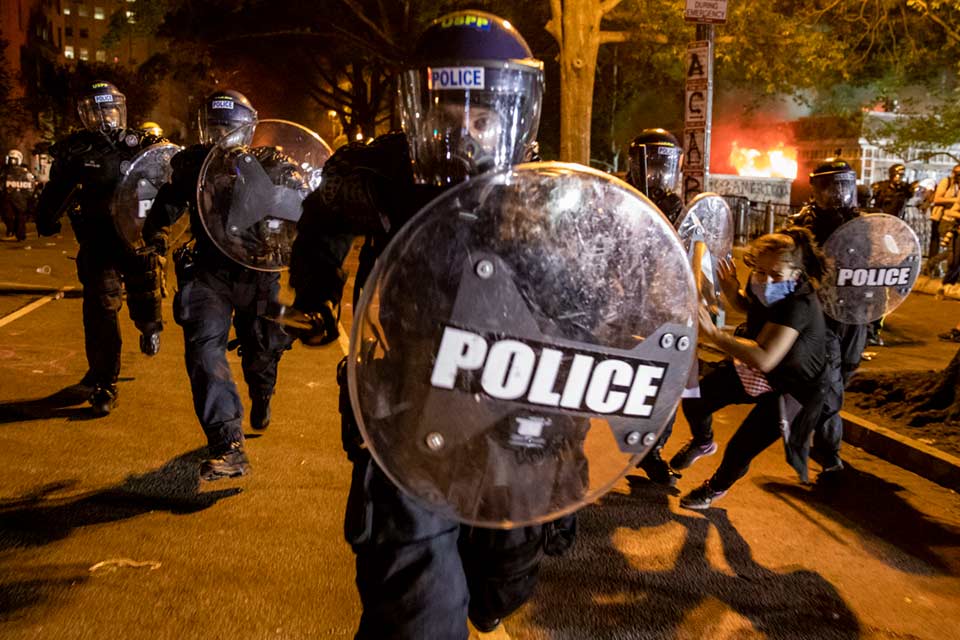
BLACK LIVES MATTER
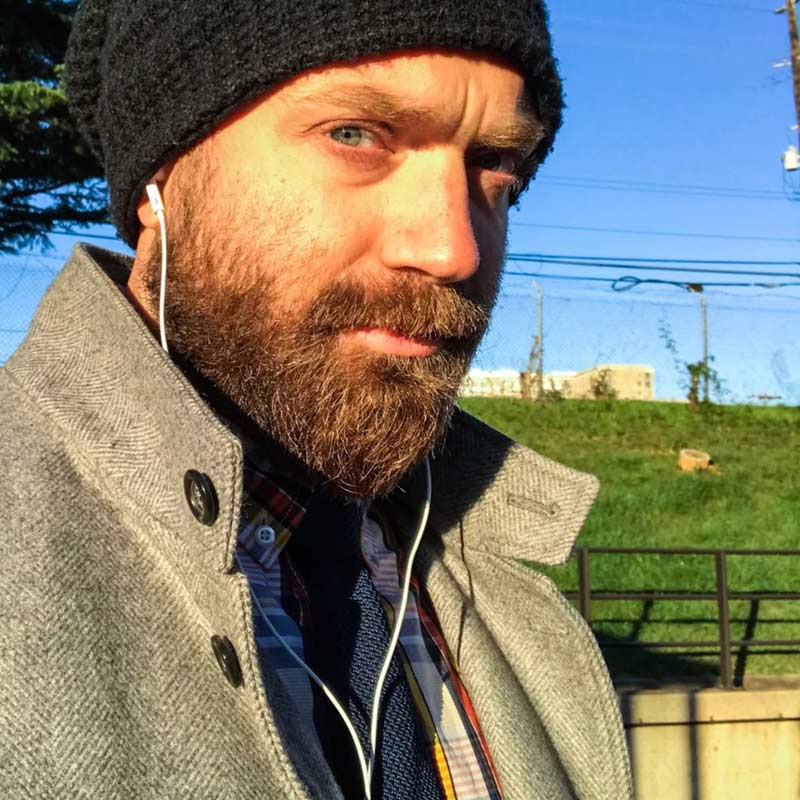
Samuel Corum is a freelance photojournalist based in Washington, D.C. He started his career in the Marine Corps and completed two combat tours as a combat photographer in Iraq. After attending the Corcoran College of Art and Design, graduating with a BFA in Photojournalism in 2012, he became a staff member at Anadolu Agency, leaving in 2018.
Since then, he is a regular contributor to The New York Times, Getty Images, EPA News’ photo service, and AFP Photo Agency.
This is the second interview with Samuel Corum published in Lens Magazin, as the first one was published in April 2019, issue #55, which featured three of Corum’s photo series.
Today, we proudly present a new interview with Corum, dedicated mostly to his photojournalism experiences throughout the Black Lives Matter demonstrations following George Floyds’ violent death on May 25th, 2020.
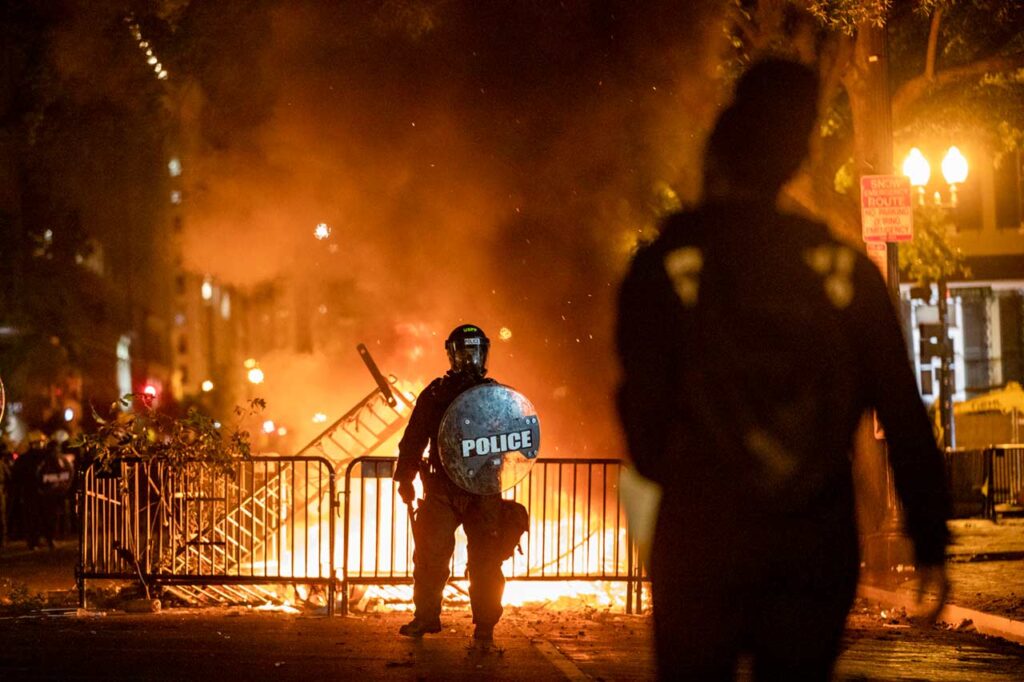
Lens Magazine: Dear Samuel, Thank you for your time. It’s always a pleasure to chat with you.
Please tell us a little bit about yourself and your journey as a photographer – your background, your service as a Marine combat photographer in Iraq, and how you became a professional photojournalist.
Samuel Corum: Well, I got my start in photography in high school, but it almost didn’t happen. It was the end of the first year of Photo 1, and I spent some extra time during finals week printing out some photos in the darkroom. I took a print out to get some feedback from the teacher, and he loved it and asked if I had signed up for Photo 2. I told him I hadn’t because I didn’t get an invitation, which was needed. He then went with me to the guidance counselor’s office and signed me up, right then and there. If that hadn’t happened, I don’t know if I would have continued!
After high school, I took a semester of community college but wasn’t a fan, so I decided to join the Marines after finding out I could get the job of a combat photographer. As a Marine combat photographer, I still had to go through all of the same basic training and combat training as every other Marine. During my two deployments to Iraq, I carried a rifle on one shoulder and my camera on the other.
My first deployment was a shorter one: I fulfilled a sports roll, gathered images from other photographers in the field, and sent them on. My second deployment was much longer, 13 months, and I spent most of that time embedded with infantry units in and around Fallujah.
In 2008, I decided to continue my education, grow as a photographer, and push myself by going to the Corcoran College of Art and Design to pursue a degree in Photojournalism.
It was an exciting time because I felt like the coursework was a bit behind the curve when it came to the industry changes, but being surrounded by other creative people, feeding off each other, and the internship opportunities were priceless.
After college, I spent a few years doing various photo-related jobs here and there, and then the protests in Ferguson broke out after Michael Brown’s death by Police. It was the first major news story to happen after my graduation, and I decided that I needed to be there, so after failing to get backing by an outlet, I drove out there overnight on my own with my own funds.
I ended up spending a week there, shooting, a former classmate put me in touch with a writer at Anadolu Agency, a Turkish news agency. I shot for them for a few days on-spec.
I didn’t make much money during those days, but it just so happened that their photographer in Washington, D.C., was going back to Turkey permanently, so they asked me to join in full-time.
L. M.: Let’s talk about the #BlackLivesMatter protests going on right now. They were sparked by George Floyd’s documented death by Police.
The demonstrations spread to cities outside of the United States.
The most recent debate topic brought up by demonstrators is Rayshard Brook’s death. What is your impression of this matter?
S. C.: The protests following the deaths of people of color at the hands of Police are a subject that I wish I didn’t have to cover, not because they are hard, but because I wish the events that triggered them had never happened in the first place. If I didn’t do what I do now,
I would be in the streets with my own sign, but I learned early on in my career that my voice has much more of an impact through photographs than any message I could write on a sign or a chant I could sing.
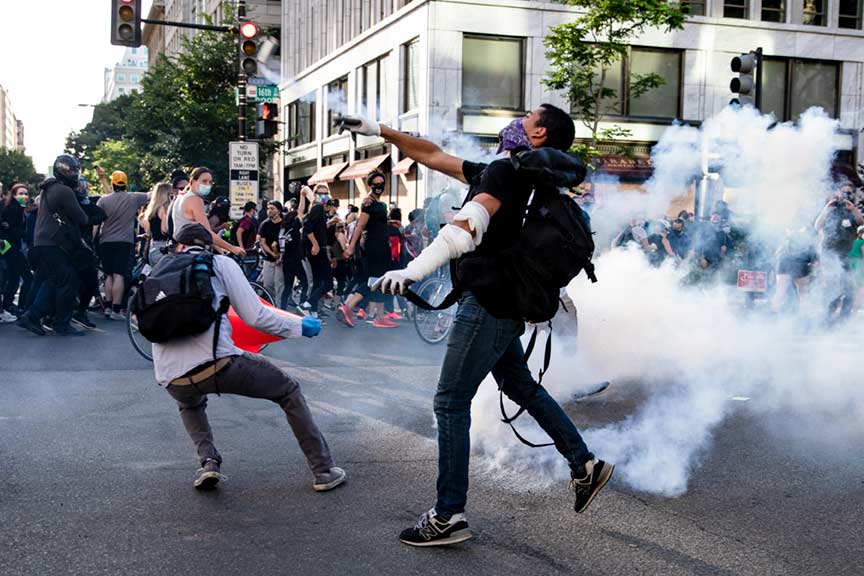
L. M.: You are based in Washington, D.C. According to your Instagram profile, you were there during the protests in front of The White House. President Donald Trump described the demonstrations as “domestic acts of terror.” He reacted to the peaceful protesters with tear gas, flash grenades, and rubber bullets. As someone who was there, do you think the protests were violent?
S. C.: If you only had one word to describe protests like the ones that happened the weekend following the death of George Floyd, it would be chaos.
In those protests, there was no central figure or organization that was in charge and calling the shots.
They were swirling masses of people that were understandably very angry, and some did feel the need to throw objects at the police lines, but that’s almost inevitable when groups reach a certain size. Unfortunately, the response from the Police was far from proportionate.
They were the harshest and most violent responses I’ve experienced from Police, including Ferguson, Baltimore, and Charlottesville. It was shocking.
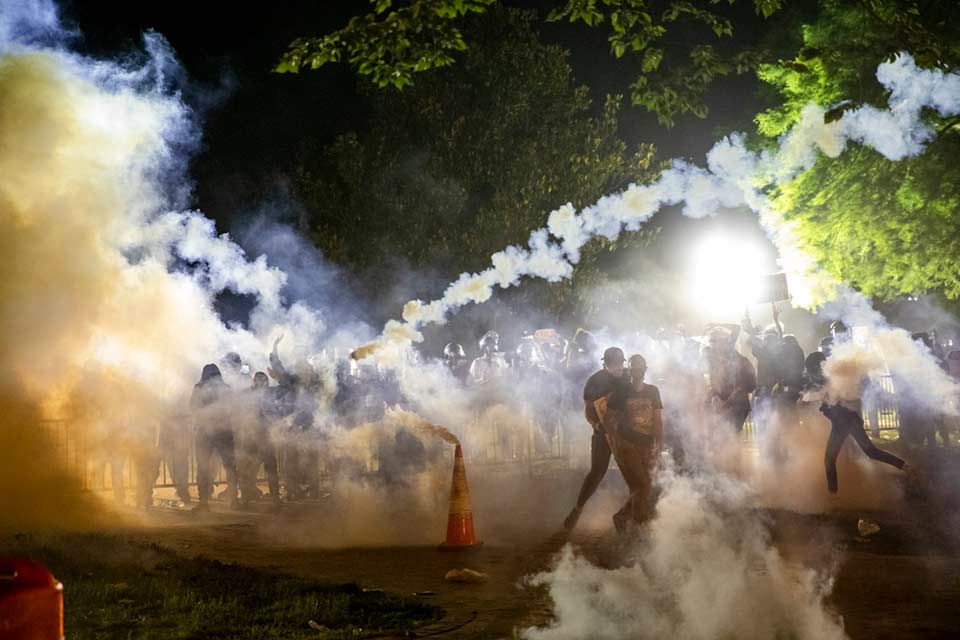
L. M.: Did you find yourself in a dangerous situation during the recent protests?
S. C.: I very much did. Closer is always better, and you have to be where the events are happening in order to tell the story properly. I inhaled tear gas, was struck by rubber bullets and pepper balls, had a Stinger Ball explode two feet in front of me, and was singled out and knocked to the ground by a charging police officer causing me to injure my elbow and knee as well as lose the lens hood on my 70-200.
L. M.: In many CNN live videos, we could see the Police and the military interfering with the photojournalists’ work; many of them were arrested for no particular reason. Did you witness anything like that?
S. C.: This was another thing that was shocking to see. There were quite a few officers that were targeting members of the press. During one charge from Police, I was able to capture images of an officer intentionally charging directly at me. I knew it was intentional because I watched him see me, make a significant course change, then run straight at me while making eye contact, which you can see in the photos. Normally, Police don’t give press special access or allow them in secure areas, but they also realize that we are there doing a job protected by the Constitution.
L.M.: As you mentioned, these rallies can be dangerous. Do you work alone?
S. C.: It depends. Sometimes I’m by myself, and sometimes I’m partnered with another print or video reporter.
I’ve almost always made contact with other photographers that I know and trust and start a text group where we stay in contact and share valuable information.
When things are really hairy, we will sometimes move in small groups and watch each other’s backs for safety.
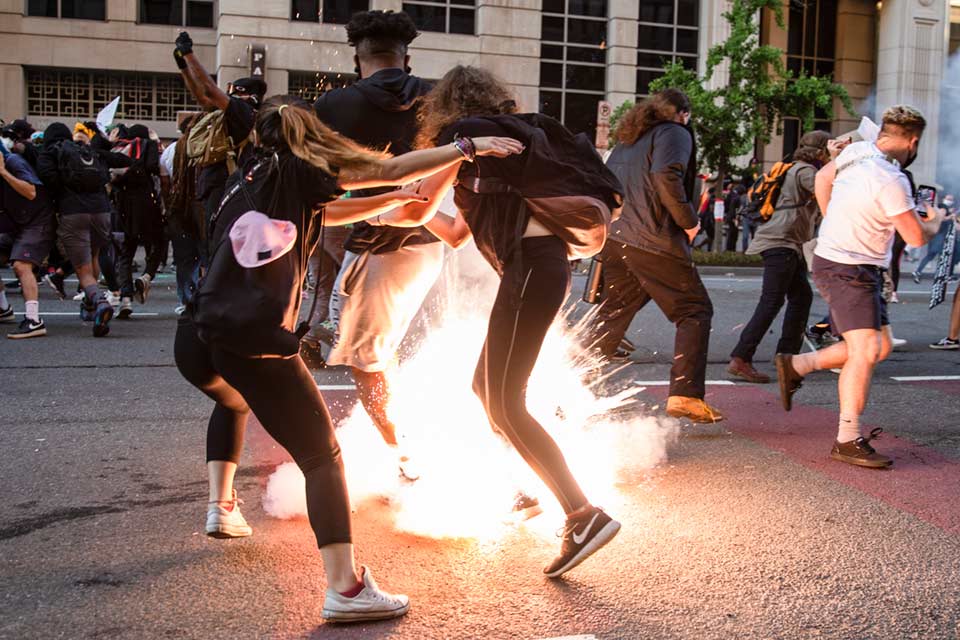
L.M.: Which photograph of yours do you feel demonstrates the air around The White House at the time of the rallies, and why?
S. C.: For me, it is the photograph of the office with the circular shield charging directly at me. It really captures the tactics the Police were using.
They would act fast and hard against protestors, and it often felt like their only goal was to cause harm because I saw very few arrests. The photograph is interesting to me because it is not technically perfect; the officer is slightly out of focus.
Still, there are many other aspects of the photograph that make it, so the soft focus doesn’t matter. From the officer frozen mid-sprint, the chilling eye contact and expression on his face, the fire in the background, and the other protesters being knocked to the ground on the right side of the frame – these all would make for good images on their own, but having them all in the same frame is special.
L.M.: What was the most emotional moment for you when covering the protests?
S. C.: It was the day after President Trump cleared the area for his photo opportunity. That was the first time I ever felt truly afraid of the Police. I was afraid of being targeted and physically harmed by the people who were supposed to protect me. While feeling this fear, I realized that it was probably just a small fraction of what a black man in America experiences on a daily basis, and that really upset me.
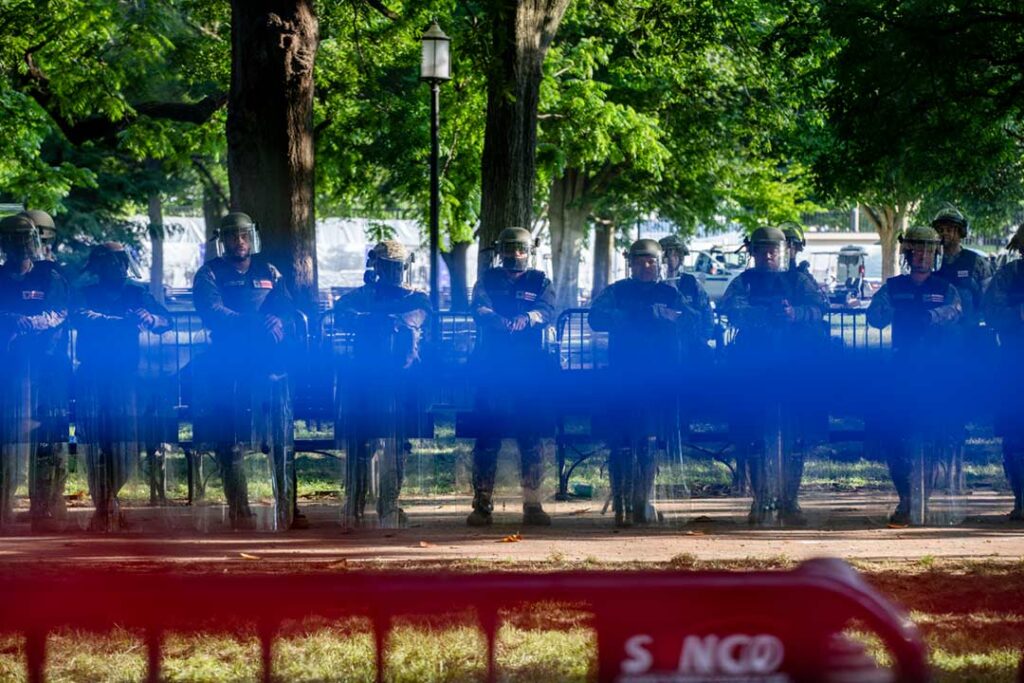
L. M.: Back in 2015, you did an excellent coverage of the Freddie Gray protest in Baltimore. In your opinion, What will be the effect of George Floyd’s demonstrations in the next 5-10 years?
S. C.: A lot of people have mentioned this in other places, but the most significant difference has been the diversity and number of white people in the crowd.
It’s significantly greater than the protests that followed the deaths of Freddie Gray and Michael Brown.
I can’t offer any insight into why there are more white people, but I can tell you that it has changed the conversation. We will see how this affects the next 5-10 years.
L.M.: We are over-flooded with images from many photographers and documentations posted by users on social media. Is Photojournalism as impactful and vital as it was in the past when mobile phones were not as common, and sharing platforms were more limited?
S. C.: Absolutely, but I also don’t think we should dismiss amateur work. Photojournalists have mastered the ability to capture a compelling and emotional representation of events in a few photographs as possible.
On the other hand, by viewing the work of everyone on platforms like Instagram and Twitter, we can have insight into many other perspectives. I always strive to be as objective as possible in how I cover an event. Still, I also acknowledge that true objectivity is impossible, and there are things I may miss or get wrong, and it doesn’t matter if it was intentional or not.
L.M.: Social media users can easily share pictures and videos, and even do live broadcasts these days. Does that impact the way you work? Do you rush to post good images to measure up?
S. C.: It has definitely put an urgency on how fast I get photos to clients. I will often send photos multiple times throughout the day, and I’ve even been known to pull out my laptop while marching!

L.M.: How diverse is the field of Photojournalism in the U.S., from your point of view?
S. C.: There is definitely room for improvement in the industry’s diversity in D.C. All you have to do is look at one of the photos of all the photographers photographing a witness in Congressional hearings to see that while males are still in the majority. I do think it is changing, though.
Unfortunately, the change is going to be slow until the older generation of photographers begins to retire from their staff positions. It’s not going to be like video journalism, because that field is mostly brand new, so it closely resembles the ideals and qualities that we try to achieve and demand.
I would love to see a breakdown of photojournalists under 30, because I feel like we are moving in the right direction but still have a long way to go.
L. M: With your respectable background of documenting war and conflict zones, can you tell us about the ‘must-have’ unique qualities and abilities that one needs in these dangerous situations?
S. C.: Being able to read a situation and have an escape plan. Don’t allow yourself to get tunnel vision. Always have your head on a swivel reading the people around you. No photograph is worth your life or those of the ones who would attempt to save you if something did happen to you.
Often during massive protests, I will hang around the fringes of crowds getting the lay of the land. I will try and figure out which groups might be more prone to violence towards myself as a journalist; I will see where the Police are forming up and have placed possible back up officers, then I will try and identify where I can escape to if things get too out of hand.
When things escalate, you want to be able to react quickly, and having that information already figured out can save you precious moments.
L. M: How do you see today’s world in terms of unity and division? Did your work as a combat photographer and a photojournalist in problematic zones, bring you to any conclusions?
S. C.: More and more, we are living our lives in echo chambers. We follow people and organizations we agree with on social media and are too quick to simply unfriend those we don’t. When we do engage with opposing points of view, we often react in ways that we would never do in person, even on Facebook, where someone’s name and the photo are displayed with their posts. It’s even worse when you throw in anonymity. Some people see that as a ticket to be the worst and most uncivil.
I’ve traveled through much of the United States and seen many different ways of life. The vast majority of people just want the best for themselves and their loved ones.
Human beings have a natural fear of the unknown and instinctively fear what they don’t know or experience as defense mechanisms.
The easiest way to break down this barrier is to experience more things outside of your comfort zone. Meet more people. Talk with them. Learn about who they are and what they’ve experienced in life.

L. M: You’ve worked in several countries, documenting both the horrors and the triumphs of humanity. What has been the most challenging story you’ve worked on to date? Why?
S. C.: Politics. It’s not because it’s hard to take photographs, because just getting a photo is easy, but it’s hard to make a unique and creative one that stands out! The politicians and their staff orchestrate events, and you’re surrounded by sometimes over a dozen of other fabulous photographers. It is always a welcome challenge to try and get something unique.

